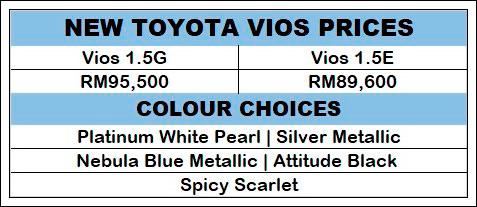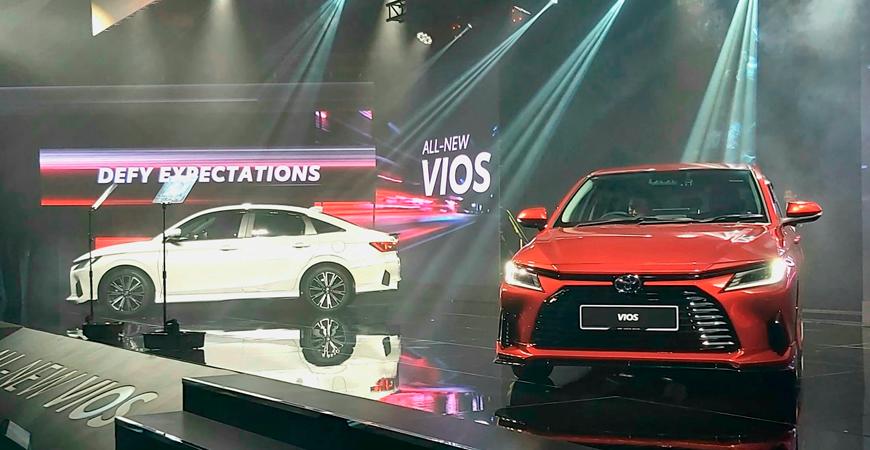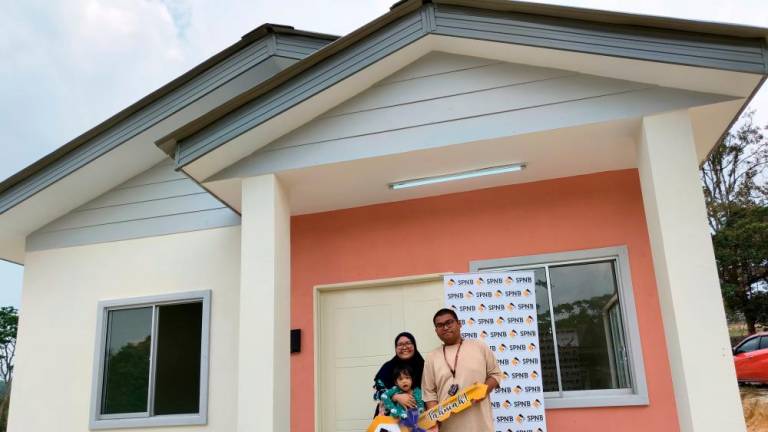UMW Toyota Motor has officially launched the all-new 4th generation Toyota Vios with two variants – Vios 1.5G and Vios 1.5E. The prices (without insurance) are RM95,500 and RM89,600, respectively. Since order-taking began February 24, over 5,000 orders have been received nationwide. These will join the more than 505,000 units that have been sold over the previous 3 generations since 2003.
As before, there’s only a 1.5-litre 4-cylinder Dual VVT-i engine with an output of 104 ps/138 Nm. The automatic transmission (no manual choice now) is a new 7-speed CVT with Shiftmatic manual selection. Paddle shifters are available in the Vios 1.5G and there are 4 driving modes to suit different driving preferences and conditions.

While the sleeker fastback-styled body is almost the same size as before – though it looks bigger – the wheelbase has been extended by 70 mm which improves space within. Besides the aerodynamically optimized form, there are also feature such as spats in certain areas to guide airflow and air vents to enhance cooling performance of the brakes. The rear air spats control and suppress airflow on the tyres and accelerates underside flow to balance with upper side, benefitting stability.
The Aeroblades for the windscreen wipers are also specially designed for less wind resistance, contributing to better aerodynamics. For the Vios 1.5G, there is the convenience of an Auto Rain Sensing system which will automatically activate the windscreen wipers when rain begins to fall on the glass.
To save weight, there is no spare tyre but a Tyre Repair Kit is provided which can be used to repair punctures and enable continuation of the journey. The omission of the spare tyre is also done from the point of view of safety and convenience for the driver. Whether this approach (of not providing a spare wheel) is acceptable to customers remains to be seen although tyres are tougher these days and the incidence of punctures is generally lower.
The Vios has all-new architecture known as DNGA which is used for smaller models in the Toyota Group, including those by Daihatsu. DNGA has been developed with weight-saving approaches without sacrificing rigidity and strength. The architecture encompasses the suspension elements as well to achieve good stability and comfort. The suspension – comprising front MacPherson struts and a rear torsion beam – provides nimble handling and enhanced straightline stability.
The cabin of the new Vios has been completed redesigned, taking into account the advantages offered by DNGA. The longer wheelbase has also allowed for better comfort with increased spaciousness, especially for the rear passengers who get more headroom, hiproom and shoulder room.
The front seats have also been redesigned for better support to reduce fatigue, especially on long journeys. The headrest shape and position are also optimized to ensure maximum support when seated and ease when getting in and out.
The new dashboard design is sleek and wide with a continuous form from door to door. For the Vios 1.5G, there is a digital instrument panel which can be customised while the Vios 1.5E is fitted with Optitron meters that are bright and clear. The Multi-Information Display (7 inches for the Vios 1.5G, 4.2 inches for the Vios 1.5E) provides the driver with all the necessary information which can be selected using switches on the steering wheel.
At the centre of the dashboard, the 9-inch touchscreen display panel is used for the audio system and infotainment system as well as the 3D Panoramic View Monitor (PVM). With wireless Android Auto and Apple CarPlay, smartphone apps (Waze, Spotify, etc) can be easily transferred to the screen and used from there. A storage space for a smartphone is available below the air-conditioner controls. Three USB charging points are provided, with one being Type-C for newer devices.
New features and equipment include ambient lighting in the cabin and rear vents, with fully automatic air-conditioning. Air quality is also improved with the inclusion of a clean air filter in the ventilation system. This helps to remove particles in the air that is recirculated or introduced through the fresh air intake.
As before, the Vios comes with the convenience of a Smart Entry & Pushstart System, making it unnecessary to use a key or even press the key fob. For the latest generation, the Smart Entry system has been upgraded with a Touch Sensor on the door handle. Just a touch on the sensor will lock/unlock the doors. For peace of mind, if the remote control key fob is not taken out by the driver, the Smart Entry system will not allow the doors to be locked.
Despite the sleek fastback design, the luggage space in the new Vios is enlarged compared to the previous generation. It now has a volume of 475 litres with a depth of 1060 mm for long items or large suitcases. However, the rear backrest cannot be folded down to extend the boot floor. The omission of folding backrests is because Toyota product planners found that the feature was not used much, and weight could be saved if it was a fixed backrest.
A folding board is provided in the boot as a partition to divide the space for different types of items. A waterproof tray is also provided which covers the whole boot floor so that wet items will not spoil the carpet and it is also easy to wash when necessary.
Besides the standard digital video camera (a rear unit is available as an option), there is Vehicle Telematics System which can track the car’s location. Subscription to this service is free for the first three years of ownership.
The new Vios now comes with Toyota Safety Sense, an integrated suite of active safety systems that help the driver to be aware of dangers and acts automatically to prevent accidents in certain situations. TSS uses a camera mounted on the top of the windscreen to monitor the road ahead for the on-board computer to assess the situation. Depending on the risk, the driver will be alerted and if no corrective action is taken, then the brakes will be activated automatically.










